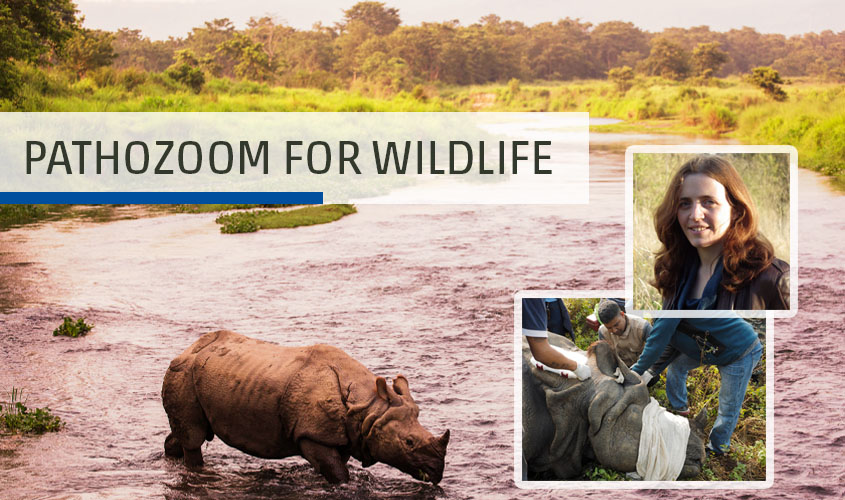22/5/7
Rhinoceros mystery in Nepal
Veterinarians on the frontlines of animal welfare with Digital Pathology
In Nepal’s Chitwan National Park, bordering India, tourists can observe rhinos from an elephants back. The rare but popular animals have only been successfully protected from poachers for a few years … and yet they are causing the veterinarians and pathologists at Wildlife Vets great concern: the mortality rate has been greatly increased for several months. And now our PathoZoom® solutions for Digital Pathology are playing a crucial role in searching for clues as to why this is happening.
Our Use Case begins with Dr Jess Bodgener, who has been working in the national park in Nepal and is trying to find the cause for the heightened mortality. She started taking samples from deceased animals and generated more than 400 slides, that needed to be sent to her colleague, Dr Carol Meteyer in the US. As a pioneer in wildlife health, she would surely be able to help solve the riddle.
But sending the slides halfway around the world by mail was simply not an option for the Wildlife Vets a UK charity that has been providing vital veterinary support to international wildlife and conservation projects since 2004.
In her search for a faster and more cost friendly alternative, Dr. Bodgener came across our various Digital Pathology solutions for quickly sharing samples to colleagues, no matter the distance. So: She inquired – and we immediately agreed to support her project. The rhinoceros’ samples were scanned on-site and uploaded to our PathoZoom® Slide Cloud, where they were available immediately to Dr Carol Meteyer.
Perfect solution for Digital Pathology without installing software
A transfer via Dropbox, for example, wasn’t an option for the medical professionals, since it would have required Dr Meteyer to download each file separately and would only be able to view the scanned sample using a special software for the file format of the scanner used. With our PathoZoom® Slide Cloud however, all scanned samples can be viewed on any browser and any device, and no special software needs to be installed. The doctors in Nepal were also able to annotated the slides with their findings, marking regions of interest and thereby supporting Dr Meteyer.
725 rhinos in the national park
We were happy to do so and are now curious to see the result of the Wildlife Vets research and even more happy healthy rhinos in the future. After all, everyone was happy that the number of rhinos in the national park had just increased again from 500 to 725 from 2015 to 2021.
Up to date via newsletter
Current trends in digital pathology, product news, expert and user meetings, tips and tool recommendations, job offer: Stay up to date with our newsletter. Register here:





